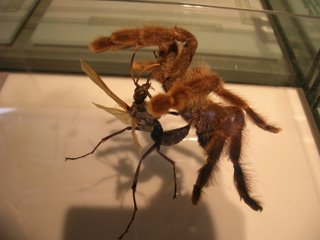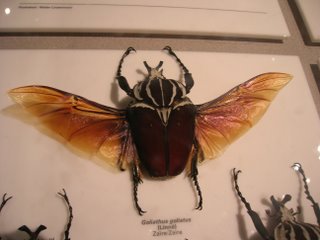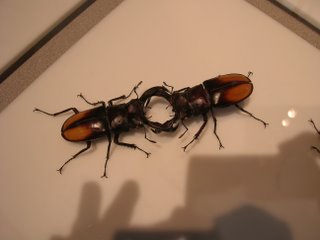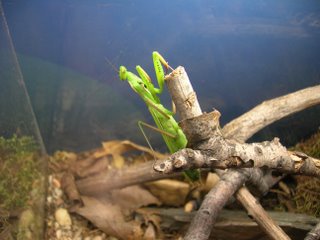Thursday, September 07, 2006
Montreal Insectarium, take one
I'll start things rolling with some Montreal Insectarium photos. These are all pix of posed or pinned, preserved specimens; I'll save the live ones for later.

Pepsis wasp attacking a tarantula.

Flat-bodied carabid beetle under bark. The visible portion of this insect was at least 5 cm long.

What does a goliath beetle wear under its elytra? Why, another pair of wings, of course!

This is an African uraniid moth, a relative of the one I photographed in Panama.


Lucanid (stag) beetles making love and war.

Pepsis wasp attacking a tarantula.

Flat-bodied carabid beetle under bark. The visible portion of this insect was at least 5 cm long.

What does a goliath beetle wear under its elytra? Why, another pair of wings, of course!

This is an African uraniid moth, a relative of the one I photographed in Panama.


Lucanid (stag) beetles making love and war.
Monday, September 04, 2006
Steve Irwin, 1962-2006

My husband and I became Steve Irwin fans one New Year’s Eve in Kalamazoo, Michigan. A cable network was celebrating the holiday by showing three or four back-to-back documentaries about snakes. It was a cold night and we had no other plans, so we watched the whole lineup. The capstone episode featured a manic blond Australian dude wrangling a wild menagerie of venomous elapids, and obviously enjoying the experience. We were hooked.
Biologists have always had, at best, mixed feelings about Steve Irwin. For one thing, he wasn’t a scientist. Instead, Irwin was a showman, a complete ham in front of the camera. Every Australian I’ve ever met has had the same response to Irwin’s American popularity that most Americans have when we hear about the alleged French estimation of Jerry Lewis. And, of course, no one really knows the effects that Stevo’s mano-a-mano interaction with animals actually had on the critters themselves. It wasn’t a scientific approach to conservation, nor was it ever meant to be.
The reason that I always felt a kinship with Steve Irwin had nothing directly to do with science, and everything to do with why I’m in science now. There are people who are so in love with other species that they have to interact with them constantly. You see it sometimes in expert gardeners among their plants. I’ve seen it in a Michigan naturalist, himself a picture of scientific focus, who smiled as he explained that he loved banding the birds he retrieved from mist nets because it permitted him “an anthropomorphic experience with the birds”. If you’ve seen any of the TV work of Georges Brossard (the “Bug Man” of the Montreal Insectarium) or any of the nature series of Jeff Corwin or Sir David Attenborough, you’ll recognize that same joy of interaction when your host is on camera.
I have it too. Anyone who knows me knows that I just can’t keep my hands off bugs. I love to touch butterflies and beetles. I used to let my giant African millipedes walk up my arm. I’ve poked a finger into the nests of biting Allegheny mound ants in order to experience their nipping mandibles and formic acid spray. I smile when Drosophila land on me in the lab. And most of my friends have, at one time or another, seen me pet a bumble bee on the thorax. I’ve even touched paper wasps and bald-faced hornets when the weather is a little chilly and the insects aren’t reacting quickly.
Most of these arthropods aren't really dangerous, but I wonder sometimes what I would do if I ever experienced a life-threatening reaction to a hymenopteran venom. Would I still study wasps and ants? Would I still pet bumble bees in the garden? My answer: I honestly don’t know. Most likely, I wouldn’t stop doing any of those things. On the one hand, I like to think that I’m very good at anticipating what a familiar insect will do. On the other, I have no illusions that I can actually control the way any live animal will react to me. I also don’t know whether touching a nectaring bee has any deleterious effect on the bee or its nestmates. But, my scientific curiosity is only part of the reason why I work with insects. I love them, and I have to be around them, the same way Steve Irwin loved his snakes and crocodiles.
On the morning of August 14, 2004, my husband and I dragged ourselves out of bed early at a friend’s place in Brisbane, so that we could catch the train to Beerwah and Australia Zoo. We had landed in Australia only the day before. I was so exhausted that I experienced bouts of vertigo all day and had trouble standing up straight. But, it was the only day we could schedule the trip, so we went to the zoo anyway. The staff would never actually tell you whether Steve was there. We didn’t see him. For a photo-op, we had to settle for the cutout shown above. It’ll have to do now, permanently.
I don’t encourage my readers to pet bumble bees; as much as I think they’re unlikely to sting under those circumstances, I can’t promise you that you won’t get stung that way. Reptile expert Jeff Corwin was once badly envenomated by a coral snake that he wasn’t even attempting to handle. Snakes and crocodiles and, sadly, stingrays can be extremely dangerous to humans. Steve Irwin walked, swam, climbed, and pushed his lawnmower close to the edge many times and lived to tell about it. His being killed in a freak attack by a normally non-aggressive sea animal seems strange – almost as if one of the Cousteaus had taken a break from the sea to go camping in Alaska and had promptly been mauled by a grizzly bear.
But, despite his over-the-top antics – or maybe even because of them – a lot of kids and adults have learned to both respect and enjoy animals that most of us used to think were ugly or terrifying. Respecting them is of utmost importance -- a crocodile is not, of course, your friend--but they have a role on this planet, and most have been here longer than we have.
As for me, the best thing I ever learned from Steve Irwin has applications beyond interactions with wildlife. Steve meant it literally, in his philosophical attitude towards a nervous, sharp-toothed little lizard he was handling on camera. Ever since, I’ve kept his one-liner in mind when coping with political arguments, recalcitrant students, and stroppy blog-commenters.
If they’re bitin’ ya, ya know you’ve got ‘em.
